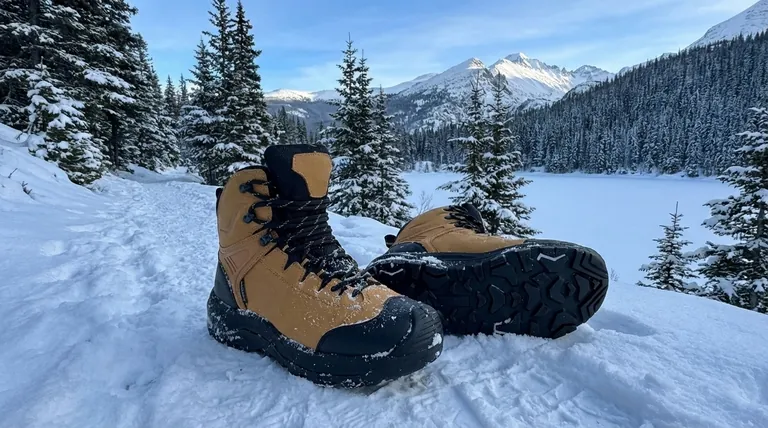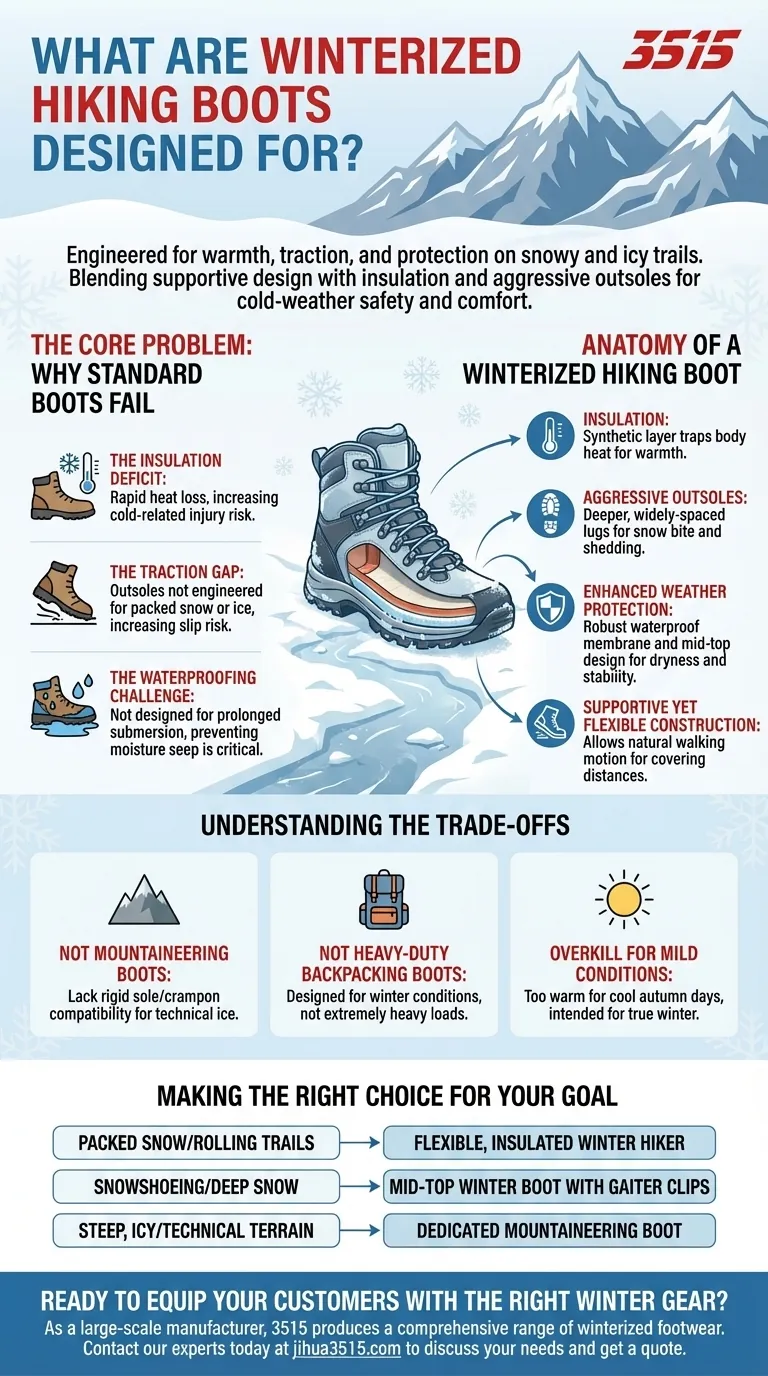Winterized hiking boots are specifically engineered to provide the necessary warmth, traction, and protection for hiking on snowy and icy trails. They blend the supportive, flexible design of a traditional hiking boot with crucial features like insulation and aggressive outsoles to ensure safety and comfort in cold-weather conditions.
The central challenge of winter hiking is that standard boots fail to provide adequate warmth or grip. Winterized hiking boots solve this by integrating insulation and specialized traction, creating a dedicated tool for safely navigating cold, slippery terrain without the extreme rigidity of a mountaineering boot.

The Core Problem: Why Standard Boots Fail in Winter
To understand the purpose of a winterized boot, it is essential to first recognize the shortcomings of standard three-season hiking boots when faced with snow and ice.
The Insulation Deficit
Standard hiking boots are not insulated. In cold, snowy conditions, this leads to rapid heat loss from your feet, causing significant discomfort and increasing the risk of cold-related injuries like frostbite.
The Traction Gap
The lug patterns on typical hiking outsoles are designed for dirt, mud, and rock. They are not engineered to bite into packed snow or grip effectively on icy surfaces, which dramatically increases the risk of slips and falls.
The Waterproofing Challenge
While many hiking boots are waterproof, they are not designed for prolonged submersion in wet snow. Winterized boots feature construction that better prevents moisture from melting snow from seeping in, which is critical for keeping feet dry and warm.
Anatomy of a Winterized Hiking Boot
Winterized boots are not just regular boots with a fleece lining. They are a purpose-built system of features designed to work together in cold environments.
Key Feature: Insulation
This is the primary differentiator. Winter boots contain a layer of synthetic insulation to trap heat and keep your feet warm, even when temperatures drop significantly. This feature is non-negotiable for winter comfort and safety.
Key Feature: Aggressive Outsoles
The outsoles on winter hikers have deeper, more widely-spaced lugs. This design aggressively bites into snow for better traction and helps shed snow to prevent it from caking onto the bottom of the boot.
Key Feature: Enhanced Weather Protection
These boots typically feature a robust waterproof membrane combined with a mid-top design. This not only keeps feet dry but also provides ankle stability and helps keep snow from getting inside the boot cuff.
Key Feature: Supportive yet Flexible Construction
Unlike rigid mountaineering boots, winterized hiking boots are designed to remain relatively light and flexible. This allows for a natural walking motion, making them ideal for covering distance on trails rather than ascending steep, technical ice.
Understanding the Trade-offs
Choosing the right footwear means understanding what a tool is—and is not—designed for. Winterized hiking boots are specialized, and that comes with clear boundaries.
They Are Not Mountaineering Boots
Winter hiking boots lack the rigid sole and crampon compatibility required for technical ice climbing or steep mountaineering. They are built for hiking on trails, not for ascending vertical ice.
They Are Not Heavy-Duty Backpacking Boots
While supportive, their primary design focus is on managing winter conditions, not necessarily carrying extremely heavy loads over 40 pounds. Dedicated heavy-duty backpacking boots have a stiffer midsole specifically for that purpose.
They Are Overkill for Mild Conditions
Using an insulated, heavily-treaded boot on a cool autumn day will lead to overly warm, sweaty, and uncomfortable feet. They are a specialized tool intended for true winter environments.
Making the Right Choice for Your Goal
Selecting the correct boot is critical for both your safety and enjoyment on the trail. Your decision should be guided by the terrain and conditions you expect to face.
- If your primary focus is day hiking on packed snow and rolling trails: A flexible, insulated winter hiker offers the perfect balance of warmth, grip, and agility.
- If your primary focus is snowshoeing or hiking in deep snow: Look for a mid-top winter boot with gaiter clips to ensure a secure system for keeping snow out.
- If your primary focus is navigating steep, icy, or technical mountain terrain: You must move beyond winter hiking boots and choose a dedicated mountaineering boot for the necessary rigidity and safety.
Choosing footwear designed for the environment is the most critical step in preparing for a successful winter hike.
Summary Table:
| Feature | Purpose |
|---|---|
| Insulation | Traps body heat to prevent cold-related injuries and keep feet warm. |
| Aggressive Outsoles | Provides superior grip on snow and ice to prevent slips and falls. |
| Enhanced Weather Protection | Keeps feet dry from wet snow and offers ankle stability. |
| Flexible Construction | Allows for a natural walking motion on winter trails. |
Ready to equip your customers with the right winter gear?
As a large-scale manufacturer, 3515 produces a comprehensive range of winterized footwear for distributors, brand owners, and bulk clients. Our production capabilities encompass all types of insulated boots designed for safety and performance in cold conditions.
We can help you source or develop the perfect winter hiking boots for your market. Contact our experts today to discuss your needs and get a quote.
Visual Guide

Related Products
- Premium Insulated Safety Boots and Shoes for Wholesale & Bulk Orders
- Safety Footwear Wholesale Manufacturer for Custom OEM/ODM Production
- Factory-Direct Wholesale Canvas Boots with High-Traction Rubber Soles
- Factory Direct Wholesale Rain Boots Durable Waterproof & Fully Customizable
- High Performance Fire-Retardant Waterproof Safety Boots
People Also Ask
- What should be considered when choosing winter work boots? Key Factors for Safety & Warmth
- Why is it important to keep feet warm in winter? Protect Your Health & Circulation
- Can insulated work boots be worn in warmer weather? Avoid Discomfort and Foot Health Risks
- Why is it important to keep feet dry during winter? Prevent Frostbite & Infections
- What is the best way to protect feet from frostbite in winter? A Complete System for Dry, Warm Feet



















